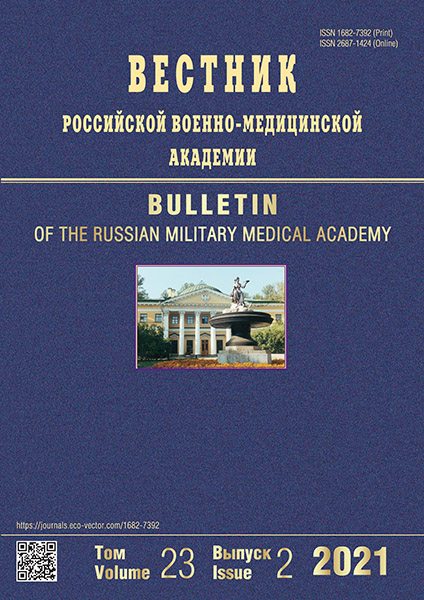Revealing of propensity to development of stress-induced somatic diseases in military university cadets based on psychophysiological, psychological and psychosocial characteristics
- Authors: Zelenina N.V.1, Fedotkina I.V.1, Nazarov S.S.1, Yusupov V.V.1
-
Affiliations:
- Military Medical Academy named after S.M. Kirov of the Ministry of Defense of the Russian Federation
- Issue: Vol 23, No 2 (2021)
- Pages: 45-52
- Section: Clinical Trials
- URL: https://journals.eco-vector.com/1682-7392/article/view/64455
- DOI: https://doi.org/10.17816/brmma64455
- ID: 64455
Cite item
Abstract
It was found that the frequency of stress-induced somatic diseases in cadets during 4–5 training years increased from 0 in the I cours to 10% in the V–VI courses. The first place in frequency is occupied by diseases of the digestive system (K00–K93 according to the International Statistical Classification of Diseases and Related Health Problem 10th revision), during the training their level increased from 0 to 7.3%. Diseases of the circulatory system (I00–I99) increased to 2.7%. Based on the psychophysiological, psychological and psychosocial indicators of the surveyed cadets, a discriminant analysis was performed and a linear classification function model for predicting the propensity to stress-induced somatic diseases was obtained. The model is statistically significant, the percentage of correct classifications is 95.8%, that indicates a good separation ability of this model. The stability of the model indicators during the entire training period is shown, so that makes it possible to use it as a prognostic model and apply to identify propensity of the junior cadet to developing stress-induced somatic diseases. Timely identification of cadets who are prone to developing stress-induced somatic diseases and personalized approach to psychological correction will contribute to the prevention of somatic health disorders, the increasing of efficiency and reliability of activity and the professional longevity of future military specialists. The indicators included in the model shows that the propensity to stress-induced somatic diseases is determined by both innate features (the speed of nervous processes and the ratio of inhibition and stimulation in the central nervous system, typological properties of the personality), and acquired skills of social behavior (coping models and psychosocial characteristics of the personality), as well as stress-induced neurotic manifestations which accumulated in the process of personal development. Psychological correction should be aimed at awareness and self-disclosure of their personal characteristics while developing the desired behavioral and social interaction skills, as well as training in mental self-regulation skills.
Full Text
About the authors
Natalya V. Zelenina
Military Medical Academy named after S.M. Kirov of the Ministry of Defense of the Russian Federation
Author for correspondence.
Email: zelnatvas@mail.ru
ORCID iD: 0000-0002-8130-7690
SPIN-code: 1173-1255
Scopus Author ID: 6701602986
https://www.elibrary.ru/author_items.asp?authorid=326460
candidate of biological sciences, associate professor
Russian Federation, Saint PetersburgIrina V. Fedotkina
Military Medical Academy named after S.M. Kirov of the Ministry of Defense of the Russian Federation
Email: vmeda_37@mil.ru
ORCID iD: 0000-0003-4838-6515
SPIN-code: 8202-2753
Scopus Author ID: 57216205440
candidate of psychological sciences, associate professor
Russian Federation, Saint PetersburgSergey S. Nazarov
Military Medical Academy named after S.M. Kirov of the Ministry of Defense of the Russian Federation
Email: vmeda_37@mil.ru
ORCID iD: 0000-0002-4532-029X
SPIN-code: 7278-3653
candidate of medical sciences, associate professor
Russian Federation, Saint PetersburgVladislav V. Yusupov
Military Medical Academy named after S.M. Kirov of the Ministry of Defense of the Russian Federation
Email: vmeda_37@mil.ru
ORCID iD: 0000-0002-5236-8419
SPIN-code: 9042-3320
Scopus Author ID: 57177317400
doctor of medical sciences, professor
Russian Federation, Saint PetersburgReferences
- Yusupov VV, Korzunin VA, Dorofeev II, et al. Realizatsiya obnovleniya metodicheskogo obespecheniya v professional’nom psikhologicheskom otbore kandidatov dlya obucheniya v vuzakh Ministerstva oborony Rossiiskoi Federatsii. Izvestiya Rossiiskoi voenno-meditsinskoi akademii. 2019;38(3):46–51. (In Russ.).
- Evdokimov VI, Mosyagin IG, Sivashchenko PP, Mukhina NA. Analiz mediko-statisticheskikh pokazatelei zabolevaemosti ofitserov Voenno-morskogo flota i Sukhoputnykh voisk Rossiiskoi Federatsii v 2003–2018 gg. Mediko-biologicheskie i sotsial’no-psikhologicheskie problemy bezopasnosti v chrezvychaynykh situatsiyakh. 2019;2:62–98. (In Russ.). doi: 10.25016/2541-7487-2019-0-2-62-98
- Myznikov IL, Polishhuk YuS. Sostoyanie zdorovya, zabolevaemost i travmatizm u vodolazov, proxodyashhix sluzhbu v Kol`skom zapolyar`e. Gigiena i sanitariya. 2014;93(40):61–66. (In Russ.).
- Telegina AI, Liferov RA, Fisun Aja, et al. Rasprostranennost faktorov riska u lyudej s arterialnoj gipertenziej, podverzhennyx professionalnoj stressogennoj nagruzke. Klinicheskaya medicina. 2017;95(6):535–544. (In Russ.). doi: 10.18821/0023-2149-2017-95-6-535-544
- Cherkashin DV, Makiev RG, Kirichenko PJu, et al. Novaya strategiya povysheniya effektivnosti profilaktiki serdechno-sosudistyx zabolevanij v Vooruzhenny`x silax Rossijskoj Federacii. Izvestiya Rossiiskoi voenno-meditsinskoi akademii. 2017;36(3):34–39. (In Russ.).
- Ojnotkinova OSh, Kryukov EV, Vlasenko AV. Ocenka prognosticheskoj znachimosti antropogennyx i ekologicheskix faktorov v razvitii neinfekcionnyx zabolevanij. Trudy NII Organizacii zdravooxraneniya i medicinskogo menedzhmenta. Moscow: Gosudarstvennoe byudzhetnoe uchrezhdenie goroda Moskvy "Nauchno-issledovatelskij institut organizacii zdravooxraneniya i medicinskogo menedzhmenta Departamenta zdravooxraneniya goroda Moskvy"; 2018. P. 8–10. (In Russ.).
- Stepanov AV, Seleznev AB, Ponomarev DB, et al. Nejroimmunnoendokrinnoe obespechenie obshhebiologicheskix reakcij organizma pri dejstvii neblagopriyatnyx vneshnix faktorov. Vestnik Rossijskoj voenno-medicinskoj akademii. 2020;4(72):196–200. (In Russ.).
- Dhama K, Latheef SK, Dadar M, et. al. Biomarkers in stress related diseases/disorders: diagnostic, prognostic, and therapeutic values. Front Mol Biosci. 2019;(6):91. doi: 10.3389/fmolb.2019.00091
- Liu Y-Z, Wang Y-X, Jiang C-L. Inflammation: the common pathway of stress-related diseases. Front Hum Neurosci. 2017;(11):316. doi: 10.3389/fnhum.2017.00316
- Senoner T, Dichtl W. Oxidative stress in cardiovascular diseases: still a therapeutic target? Nutrients. 2019;11(9):2090. doi: 10.3390/nu11092090
- Contractor AA, Armour C, Shea MT, et al. Latent profiles of DSM-5 PTSD symptoms and the “Big Five” personality traits. J Anxiety Disord. 2016;37:10–20. doi: 10.1016/j.janxdis.2015.10.005
- Koffel E, Kramer MD, Arbisi PA, et al. Personality traits and combat exposure as predictors of psychopathology over time. Psychol Med. 2016;46(1):209–220. doi: 10.1017/S0033291715001798
- Kupper N, Denollet J. Type D personality as a risk factor in coronary heart disease: a review of current evidence. Curr Cardiol Rep. 2018;20(11):104. doi: 10.1007/s11886-018-1048-x
- Zelenina NV, Fedotkina IV, Yusupov VV. Lichnostnye osobennosti kak prediktory stress-indutsirovannykh somaticheskikh zabolevanii u kursantov voennogo vuza. Mediko-biologicheskie i sotsial’no-psikhologicheskie problemy bezopasnosti v chrezvychainykh situatsiyakh. 2020;2:93–99. (In Russ.). doi: 10.25016/2541-7487-2020-0-2-93-99
Supplementary files








